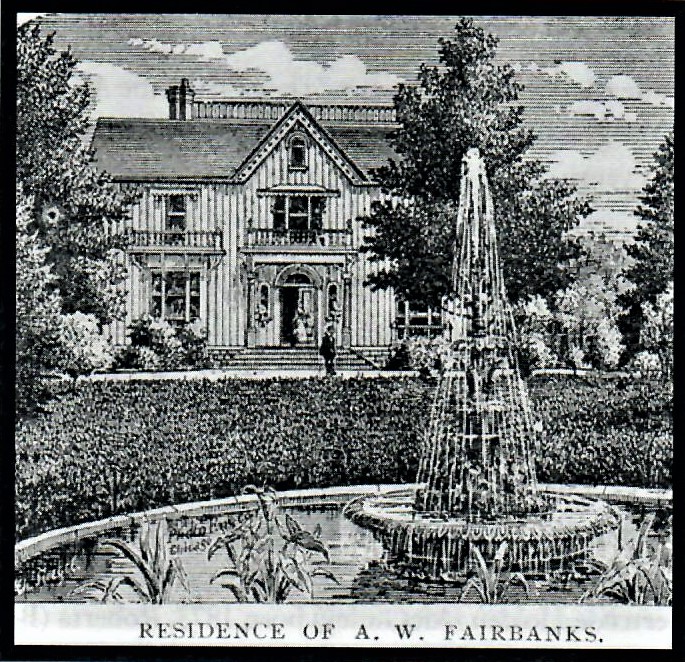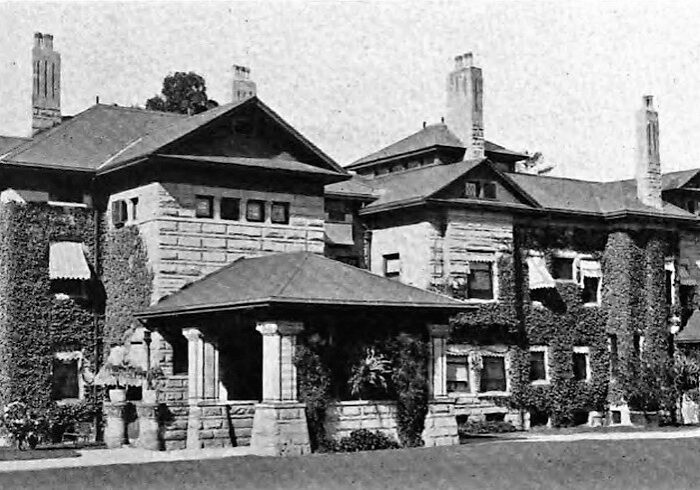Places
Homes Past
8907 Lake Shore Boulevard "Loch Hame"
Plat Nos. 631-01-001, 631-01-012, 631-01-013, 631-01-014 and 631-01-015
Sublot 8 in the Bratenahl Allotment

Abel and Mary Fairbanks purchased the 15.52-acre subplot eight from Mary Bratenahl on December 16, 1870. They were perhaps the first family to buy a sizeable property in the area who had no interest in farming.
The property was located north of Salisbury Avenue (Holden Lane), continuing to Lake Erie. The west side of the property was Bratenahl Lane (East 88th Street).
Fairbanks razed the house and replaced it with a new country home. Around 1890, Liberty holden had the home demolished to build Loch Hame.

Liberty and Delia Holden acquired their Bratenahl homestead from William Gordon on June 10, 1881, the same day Gordon purchased it from Abel Fairbanks. There were two entrances to the property: one on Bratenahl Lane (East 88th Street and Salisbury Avenue) (Holden Lane).
The Holdens lived at 7809 Euclid Avenue and summered in the Fairbank’s frame home on the property before deciding to raze the frame home. They commissioned architect Charles Schweinfurth to design a sandstone-clad thirty-four room Tudor manor house to accommodate the seven Holden children.
Charles Frederick Schweinfurth was born on September 3, 1856, in Auburn, New York. His first architectural assignment in Cleveland was a grand stone mansion on Euclid Avenue for Sylvester Everett. By 1910, Schweinfurth had completed at least 15 residential designs for prominent and wealthy Clevelanders on Euclid Avenue’s “Millionaires’ Row” between East 12th and East 40th streets.
Significant commissions included the Union Club in 1905 and Trinity Cathedral & Parish House in 1907, which many critics and historians deem his most exceptional work. In addition, he designed several buildings on the early Adelbert and Mather college grounds.
Schweinfurth designed three other Bratenahl residences: the Salisbury home at 489 East 88th Street, Samuel Mather's Shoreby at 12023 Lake Shore Boulevard, and the Fuller home at 12817 Lake Shore Boulevard.
The home, completed in 1899, included a greenhouse and servants’ quarters. A Georgian coach house was built some years after the completion of the main house. “Loch Hame” became their primary home after selling their Euclid Avenue home in 1905. The name, Loch Hame, was inspired by Liberty Holden's love of the poetry of Robert Burns.
The interior of the house had either mahogany or quartered oak woodwork. Mahogany doors throughout were two inches thick.
When Bratenahl became a village, a portion of the house was in Cleveland, and a portion was in Bratenahl. Holden did not have to pay the higher Cleveland taxes because their kitchen was legally on the Bratenahl side of the property line, and it was judged that the kitchen was where one lived.
Windsor and Delia White took Loch Hame as their primary home on November 1, 1916, when they moved from 9432 Lake Shore Boulevard. During their residency, a large Georgian-style garage was completed in 1924 to provide additional quarters for cars and staff. A greenhouse was also added. The current address is 9303 and 9305 Holden Lane.
Guerdon Stearns Holden, the youngest and only surviving son of Liberty, and Delia Holden became the reluctant owner of Loch Hame on January 27, 1930, after the Whites decided to live all year in their Hunting Valley home. Guerdon had been happily residing at 10316 Brighton Road.
Refusing to sell to his relatives, Guerdon placed the property in the hands of a flamboyant realtor who ran ads cajoling the Village to permit the commercial use of the property out of gratitude for all the Holden family had done for the Village. As if this wasn't embarrassing enough, the realtor offered the property for sale in small parcels, so limited that the purchaser of the manor house would own neither entrance gate. By this time, any supposed debt owed to the family was forgotten in the general outrage.
Joseph and Margherita Baruzzi acquired the manor home on July 14, 1950. Mr. Baruzzi, his wife, his wife’s mother, son, son’s wife, two daughters, and their husbands, plus two small children and two puppies, all lived in one house. Thus, as many as 64 persons may have occupied the home.
The fragmented land with its outbuildings went to a variety of buyers, and the house stood neglected. Repeated efforts by the village to enforce the code regarding the home’s occupancy proved futile. As a result, the western entrance to the Village, once it's most impressive and beautiful, never recovered.
The United States Government took title to the condemned property on August 24, 1956. On November 27, 1956, The Baruzzi family was ordered to be out of the house by December 1, 1956. U. S. District Judge Paul Jones ordered the U. S. deputy marshals to evict the family if necessary. Judge Jones heard the pleas of Margherita Baruzzi to spare her home because she was there by the “will of God” and felt constrained to stay as long as possible.
Judge Jones, at 75, a man of great patience, spoke kindly to the woman. From the Scriptures, he quoted St. Peter as admonishing the early Christians to “obey every ordinance of man.” He also told Mrs. Baruzzi that if it were God’s will that she remain in the house, then “surely He would have communicated with me, knowing that I would have to decide the matter.”
The Baruzzi lawyers later thanked the judge for his patience. They said they believed his remarks had helped Mrs. Baruzzi to the inevitable. The inevitable happened on November 27, 1956, when the Judge signed the eviction decree. After that, the United States Government demolished it to become part of the Nike Missile Site.
